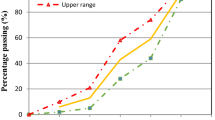Abstract
Buton rock asphalt (BRA) is used as a modifier in road applications to enhance the performance of asphalt pavement mixtures. Rock-modified sand–asphalt (RMSA) concrete can be prepared by adding BRA to sand–asphalt (SA) concrete. In this study, BRA was added to SA concrete through wet and dry modification processes. In the dry modification process, BRA was directly added to SA concrete. In the wet modification process, pure rock asphalt (PRA) extracted from BRA was preblended with the base asphalt of SA concrete. We evaluated the engineering properties of RMSA concrete through comprehensive laboratory tests. The comparison and control groups comprised RMSA concrete and polymer-modified sand–asphalt (PMSA) concrete. The test results indicated that the Marshall stability and indirect tensile strength of RMSA were higher than those of the unmodified sand–asphalt (USA) concrete and PMSA concrete. Regarding durability, the index of retained strength (IRS) and tensile strength ratio (TSR) of RMSA were higher than those of PMSA. Thus, adding BRA to SA concrete can improve its moisture damage resistance and durability. The dynamic stability (DS) of RMSA was higher than that of USA concrete and close to that of PMSA. Overall, BRA was found to be suitable for use in conjunction with SA concrete. We recommended that the PRA content should not exceed 15% by weight of the rock-modified asphalt binder. The addition of BRA improved the mechanical properties, moisture damage resistance, permanent deformation resistance, and high-temperature performance of RMSA. The feasibility of BRA addition to SA concrete was validated.
















Similar content being viewed by others
References
Widyatmoko, I., & Elliott, R. (2008). Characteristics of elastomeric and plastomeric binders in contact with natural asphalts. Construction and Building Materials, 22(3), 239–249.
Li, Y., Chen, J., Yan, J., & Guo, M. (2018). Influence of Buton rock asphalt on the physical and mechanical properties of asphalt binder and asphalt mixture. Advances in Materials Science and Engineering, 2018(1–2), 1–7, https://doi.org/10.1155/2018/2107512.
Li, R., Karki, P., Hao, P., & Bhasin, A. (2015). Rheological and low temperature properties of asphalt composites containing rock asphalts. Construction and Building Materials, 96, 47–54.
Du, Q. L., Wang, Q. K., & Wang, G. Q. (2005). Research on appraisal of BMA road performance. Highway, 8, 133–135.
Liu, S. T., Yang, Y. S., Fang, J. G., & Guo, Z. Y. (2007). Experimental research of bituminous mixtures modified by Buton rock asphalt. Journal of Tongji University (Natural Science), 35(3), 351–355.
Zou, G., & Wu, C. (2015). Evaluation of rheological properties and field applications of Buton rock asphalt. Journal of Testing and Evaluation, 43(5), 1146–1156.
Du, S., & Liu, C. (2012). Performance evaluation of high modulus asphalt mixture with Button rock asphalt. Advanced Materials Research, 549, 558–562.
Suaryana, N. (2016). Performance evaluation of stone matrix asphalt using Indonesian natural rock asphalt as stabilizer. International Journal of Pavement Research and Technology, 9, 387–392.
Zhong, K., Yang, X., & Luo, S. (2017). Performance evaluation of petroleum bitumen binders and mixtures modified by natural rock asphalt from **njiang China. Construction and Building Materials, 154, 623–631.
Huang, W., & Xu, G. (2013). Experimental study of high temperature properties and rheological behavior of Iranian rock asphalt. Advanced Materials Research, 671–674, 1277–1281.
Praticò, F. G., Giunta, M., Mistretta, M., & Gulotta, T. M. (2020). Energy and environmental life cycle assessment of sustainable pavement materials and technologies for urban roads. Sustainability, 12, 704. https://doi.org/10.3390/su12020704.
Omranian, S. R., Hamzah, M. O., Gungat, L., & Teh, S. Y. (2018). Evaluation of asphalt mixture behavior incorporating warm mix additives and reclaimed asphalt pavement. Journal of Traffic and Transportation Engineering English Edition, 5(3), 181–196.
Public Construction Commission. (2010). Dense–graded modified asphalt concrete pavement. Specification for Construction of Public Construction Engineering-02796, Executive Yuan, ROC.
Chen, X., Liu, J., Lin, J., & Hong, J. (2016). Study on the performance of cold–recycling asphalt mixture influenced by activity sites of lignin via chemical analysis. Journal of Testing and Evaluation, 44(1), 498–506.
Shen, D. H., Wu, C. M., & Du, J. C. (2008). Performance evaluation of porous asphalt with granulated synthetic lightweight aggregate. Construction and Building Materials, 22, 902–910.
Wang, M., & **ng, C. (2021). Evaluation of microstructural features of Buton rock asphalt components and rheological properties of pure natural asphalt modified asphalt. Construction and Building Materials, 267, 121132.
American Society for Testing and Materials. (2010). Standard viscosity-temperature chart for asphalts. ASTM D2493/D2493M-09. West Conshohocken, PA: ASTM International.
Asphalt Institute. (1992). Model construction specifications for asphalt concrete and other plant–mix types. AI SS-1.
Liu, S., Cao, W., Li, X., Li, Z., & Sun, C. (2018). Principle analysis of mix design and performance evaluation on superpave mixture modified with buton rock asphalt. Construction and Building Materials, 176, 549–555.
Directorate General of Highways. (2019). General requirements for asphalt concrete. Construction Instructions-02741, Ministry of Transportation and Communications, Taiwan, ROC.
Lv, S., Fan, X., Yao, H., You, L., You, Z., & Fan, G. (2019). Analysis of performance and mechanism of Buton rock asphalt modified asphalt. Journal of Applied Polymer Science, 136(1), 46903.
Acknowledgements
Funding support of this study from the National Science Council (NSC) of the Taiwan Executive Yuan, under Grant NSC-102-2221-E-011-132 is gratefully acknowledged.
Author information
Authors and Affiliations
Corresponding author
Rights and permissions
About this article
Cite this article
Shen, DH., Chang, SC., Kuo, MF. et al. Evaluation of Engineering Properties of Rock-Modified Sand–Asphalt Concrete. Int. J. Pavement Res. Technol. 15, 1227–1238 (2022). https://doi.org/10.1007/s42947-021-00084-4
Received:
Revised:
Accepted:
Published:
Issue Date:
DOI: https://doi.org/10.1007/s42947-021-00084-4




